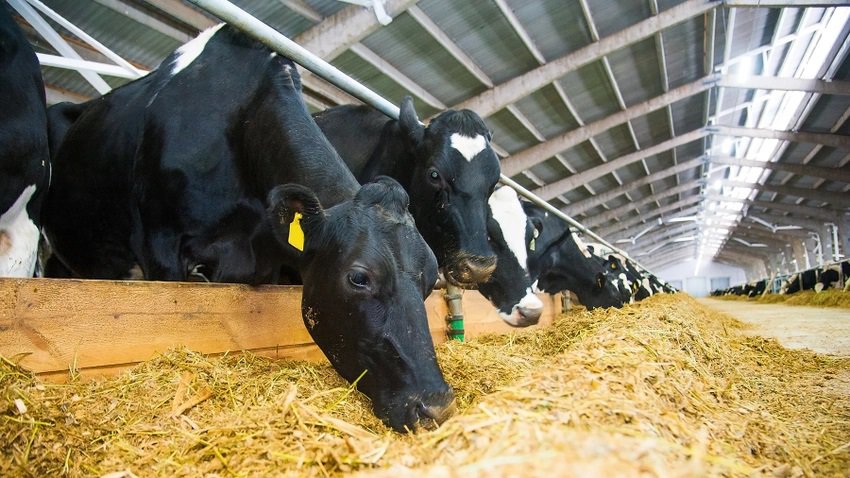
The nation’s benchmark milk price reversed two months of decline in February but still has a ways to go to return profitability to most U.S. farms. The Federal order Class III price was announced at $16.08 per hundredweight, up 91 cents from January but still $1.70 below February 2023.
Late Friday morning futures portend a March price at $16.77. April was at $16.74, May at $17.19, June at $17.74, July at $18.05, August at $18.49, September at $18.71, October at $18.78, November at $18.65 and December was at $18.10.
The plunge in whey prices this week and butter’s descent is pressuring the futures markets. The Class III breakeven price varies widely and is dependent on a number of factors but currently ranges $18 to $22 per hundredweight.
The February Class IV price is $19.85, up 46 cents from January and 99 cents above a year ago.
After a bullish December Cold Storage report showing a large drawdown on butter, the Agriculture Department’s January data told a different story.
Butter holdings jumped to 249.1 million pounds, up 49.5 million pounds or 24.8% from December, which had no revision. But stocks were 15.2 million pounds or 5.8% below those a year ago.
American type cheese slipped to 836.4 million pounds, down 1.3 million pounds or 0.2% from December, but were up 13.0 million or 1.6% from a year ago.
The “other” cheese holdings climbed to 596.2 million pounds, up 12.5 million pounds or 2.1% from December, but down 3.6 million or 0.6% from a year ago.
The January 31 cheese inventory totaled 1.454 billion pounds, up 11.8 million pounds or 0.8% from December, largest since Oct. 2023, and was up 7.7 million pounds or 0.5% from a year ago.
Back on the farm, a drop in the U.S. all milk price was not offset by lower corn, soybean and hay prices in January and thus the milk feed price ratio was pulled lower for the second consecutive month. The USDA’s latest Ag Prices report shows the January ratio at 1.98, down from 2.00 in December and the lowest since September 2023, but compares to 1.73 in January 2023.
The index is based on the current milk price in relationship to feed prices for a ration consisting of 51% corn, 8% soybeans and 41% alfalfa hay. One pound of milk would purchase 1.98 pounds of dairy feed of that blend.
The all milk price averaged $20.10 per cwt. with a 4.35% butterfat test, down 50 cents from December, and $3 below January 2023, which had a 4.23% test.
California’s average at $20.per cwt., was down 90 cents from December, and $3.90 below a year ago. Wisconsin’s, at $18, was down $1 from December and $4 below a year ago.
The national corn price averaged $4.74 per bushel, down 6 cents from November, after gaining 14 cents the previous month, and $1.89 below a year ago.
Soybeans averaged $12.80 per bushel, down 30 cents from December, after gaining a dime the month before, and was $1.70 per bushel below a year ago.
Alfalfa hay slipped to $202 per ton, down $3 from December and $61 below a year ago.
Looking at the cow side of the ledger, the January cull price for beef and dairy combined crept up to average $103 per cwt., up $2 from December, $21.30 above January 2023, and $31.40 above the 2011 base average.
January quarterly replacements averaged $1,890 per head, up $40 from October, and $170 above Jan. 2023. Cows averaged $1750 per head in California, down $50 from October, and $70 below a year ago. Wisconsin’s average, at $2,060 per head, was up $70 from October and $250 above Jan. 2023.
Milk production margins dropped below $10 per cwt. for the first time since Sept. 2023, according to dairy economist Bill Brooks of Stoneheart Consulting in Dearborn, Missouri, and were 34 cents per cwt. below December.
“Income over feed costs in January were above the $8 per cwt. level needed for steady to higher milk production for the fifth month in a row. Input prices were lower, but all three input commodities remained in the top six for January all time.” He adds that “Feed costs were the fifth highest ever for the month of January and the seventieth highest of all time.” “The ratio was below the 5-year average for the twentieth month running, as the average ratio for January is 2.07.”
“Milk income over feed costs for 2023 came in at $8.14 per cwt.,” says Brooks, “and were near the level needed to maintain or grow milk production. Profitability was down $3.77 per cwt. from 2022 and $1.58 lower than the 2018-22 average.”
“Looking at 2024, milk income over feed costs (using Feb. 29 CME settling futures prices for milk, corn and soybeans plus the Stoneheart forecast for alfalfa hay) are expected to be $13.25 per cwt., a gain of $5.11 per cwt. versus 2023. Income over feed in 2024 is $1.19 per cwt. higher than last month and would be above the level needed to maintain or grow milk production,” Brooks concludes.
The week ending Feb. 17 saw 59,300 dairy cows go to slaughter, down 2,400 from the previous week, and 8,600 or 12.7% below a year ago. Year to date, 396,700 head have been culled, down 77,200 or 16.3% from a year ago.
Meanwhile, dairy farmers are being encouraged to sign up for the Dairy Margin Coverage (DMC) program. Signup began Feb. 28 and runs through April 29.
The National Milk Producers Federation says, “The DMC is improved from the previous farm bill, thanks to the permanent incorporation of updated production histories in the program, and recent low producer margins underscore just how critical DMC is for dairy farms of all sizes.”
“Dairy producers are also struggling across the pond,” writes the Daily Dairy Report’s Sarina Sharp in the Feb. 23 Milk Producers Council newsletter. “Milk output in Europe and the United Kingdom fell 0.7% year-over-year in December,” says Sharp. “Poland was the only country in the bloc’s seven largest dairy nations with greater milk output in December 2023 than in the final month of 2022.”
“Tractors have blocked traffic in cities around Europe as the farm sector protests the red tape in the bloc’s Green Deal. Farmers are also angry about rising fuel costs and competition from imports that are not subject to similarly onerous regulations. In a sign of agriculture’s growing political power, the EU Commission simplified or reduced some of the requirements in the bloc’s Common Agricultural Policy, gave farmers some flexibility from government mandates to fallow farmland, and withdrew a plan that would have halved pesticide use by 2030,” says Sharp.
CME block cheddar closed March 1 at $1.55 per pound, unchanged on the week but 11.75 cents below its February 1 post, and 40 cents below a year ago.
The barrels got to $1.67 Monday, highest since Nov. 15, 2023, but finished Friday at $1.65, up 3.50 cents on the week, 11 cents above their February 1 post, 7.50 cents above a year ago, and 10 cents above the blocks.
Sales totaled 12 loads for the week and 62 for the month of February, down from 81 in January. There were 16 sales of barrel on the week and 45 for February, down from 113 in January.
Mid-week spot milk prices ranged from 25 cents to $2.50 over Class this week, according to Dairy Market News. Last year, they ranged $10-$2.50 under Class. Some cheesemakers say they are using internally sourced milk, but handlers’ offers have been mum. That’s expected to change as Class I demand slows and milk production increases seasonally, reports DMN. Cheese demand remains lackluster according to a number of Midwest cheesemakers, though some, particularly barrel makers, say demand is better.
Cheese demand In the West is mixed. Some manufacturers and distributors say retail demand is stronger while others say it’s flat. Food service is varied and international buying is stronger. Class III milk is tighter in some parts of the region but enough to accommodate strong to steady production, says DMN.
Butter headed south this week falling to a Friday finish at $2.7575 per pound, down 9.25 cents on the week, lowest since Feb. 16, but still 41.25 cents above a year ago. 31 cars sold on the week and 80 for the month, up from 63 in January.
Butter makers had expectations in late January that cream would be full through the second month of the year and DMN says their expectations materialized. Cream multiples have held from flat market to around 1.20. Demand is slowly starting to tick higher for milkfat and not specifically from just butter makers. There are expectations that churning, which has been very busy this year, will take a step back in coming weeks. Butter demand is holding somewhat steady at a seasonally light pace, according to DMN.
Cream is plentiful throughout most of the West and churns continue to run at-or-near capacity to ensure supplies for later quarter demand and during planned summer downtime. Domestic demand is strong to steady while export interest is steady to lighter, says DMN.
Grade A nonfat dry milk closed the week at $1.1975 per pound, 0.25 cents lower but 2 cents above a year ago. 16 loads sold on the week and 61 for February, down from 63 in January.
CME dry whey tumbled this week, falling to 42.50 cents per pound Friday, down 9.75 cents on the week, lowest since Jan. 18, and 2 cents below a year ago. Sales totaled 7 loads on the week and 13 for February, down from 19 in January.
The Feb. 29 Daily Dairy Report says “The strong dollar has made European whey increasingly competitive. Since the turn of the year, the U.S. dollar has advanced 2.4% against the euro, effectively trimming European whey by a further 2.4% relative to U.S. product.”
StoneX reported that Chinese data suggests China continues to liquidate its cow herd and “could be a medium term headwind for whey demand. In January the herd was at 40.67 million head, 3 million head less than a year prior, and a 1.8% decrease from December.”
Tuesday’s GDT Pulse saw 4.28 million pounds of product sold, down from 4.35 million on Feb. 13, with 97.1% of the total offered sold. Prices were sharply lower with whole milk powder down 2.6% from the Event last week while skim milk powder was down 2.7%. The March 2 GDT is expected to lose more ground.
Demand was sharply lower for most buying regions, reports StoneX. “It is no guarantee that we will see this again, but volume available is less than it was at this time last year. Typically the GDT auction sees a seasonal decline in volume from January through the end of the season.”
StoneX also warned, “While some of this weakness is probably driven by weaker demand the supply outlook for New Zealand has also been shifting higher.” “Weather conditions, as measured by the pasture growth index, climbed back above year ago levels in late January and have remained supportive through the first half of February with the South Island looking better than the North Island.”
Dairy exports continue via the farmer subsidized Cooperatives Working Together program. Member cooperatives accepted five offers of export assistance this week that helped them capture sales of 1.1 million pounds of American type cheese and 112,000 pounds of anhydrous milkfat.
The product is going to customers in Asia, Central America, the Caribbean and Middle East-North Africa, and will be delivered through June and brings year to date CWT sales to 20.1 million pounds of American type cheeses, 112,000 pounds of anhydrous milkfat, 7.1 million pounds of whole milk powder and 1.3 million pounds of cream cheese. The products are going to 18 countries and are the equivalent of 251.4 million pounds of milk on a milkfat basis.
Our hearts and prayers went out to Texas this week as the second largest wildfire in Texas’ history was raging in the Panhandle, in Hutchinson, Hemphill, and Roberts counties, north and west of Amarillo and into Oklahoma.
HighGround Dairy economist Betty Berning reported in the March 4 “Dairy Radio Now” broadcast that at least 1.1 million acres have been impacted, affecting more beef operations than dairy. Texas dairy cow numbers are still depressed from the devastating barn fire last spring in Dimmitt, but Berning pointed out that beef operations in Texas were more at risk than dairy operations.
It comes at a bad time, according to Berning, as the beef cow herd on January 1, was at its lowest level in 63 years. Dairy cow inventories are also low, she said, so prices have risen and is why we saw high slaughter rates last year in dairy. She warned that, depending on how this fire impacts the beef herd, “Dairy producers might be led to continue to breed to beef or, if prices get high enough, to send some of their stock to the packing plant to get a nice paycheck.”
Lee Mielke is a graduate of Brown Institute in Minneapolis, Minnesota. He’s formerly the voice of the radio show “DairyLine” and his column appears in agricultural papers across the U.S. Contact him at lkmielke@juno.com.























